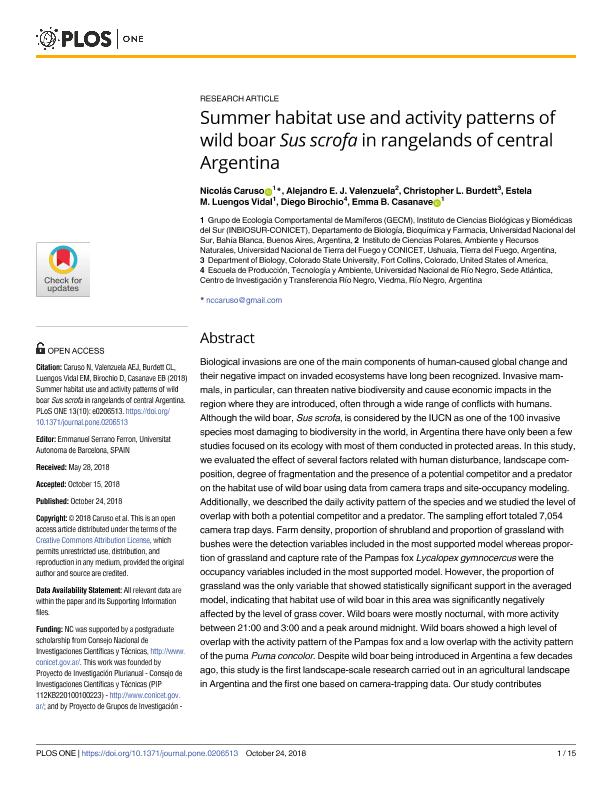Artículo
Summer habitat use and activity patterns of wild boar Sus scrofa in rangelands of central Argentina
Caruso, Nicolás ; Valenzuela, Alejandro Eduardo Jorge
; Valenzuela, Alejandro Eduardo Jorge ; Burdett, Christopher L.; Luengos Vidal, Estela Maris
; Burdett, Christopher L.; Luengos Vidal, Estela Maris ; Birochio, Diego Enrique; Casanave, Emma Beatriz
; Birochio, Diego Enrique; Casanave, Emma Beatriz
 ; Valenzuela, Alejandro Eduardo Jorge
; Valenzuela, Alejandro Eduardo Jorge ; Burdett, Christopher L.; Luengos Vidal, Estela Maris
; Burdett, Christopher L.; Luengos Vidal, Estela Maris ; Birochio, Diego Enrique; Casanave, Emma Beatriz
; Birochio, Diego Enrique; Casanave, Emma Beatriz
Fecha de publicación:
24/10/2018
Editorial:
Public Library of Science
Revista:
Plos One
ISSN:
1932-6203
Idioma:
Inglés
Tipo de recurso:
Artículo publicado
Clasificación temática:
Resumen
Biological invasions are one of the main components of human-caused global change and their negative impact on invaded ecosystems have long been recognized. Invasive mammals, in particular, can threaten native biodiversity and cause economic impacts in the region where they are introduced, often through a wide range of conflicts with humans. Although the wild boar, Sus scrofa, is considered by the IUCN as one of the 100 invasive species most damaging to biodiversity in the world, in Argentina there have only been a few studies focused on its ecology with most of them conducted in protected areas. In this study, we evaluated the effect of several factors related with human disturbance, landscape composition, degree of fragmentation and the presence of a potential competitor and a predator on the habitat use of wild boar using data from camera traps and site-occupancy modeling. Additionally, we described the daily activity pattern of the species and we studied the level of overlap with both a potential competitor and a predator. The sampling effort totaled 7,054 camera trap days. Farm density, proportion of shrubland and proportion of grassland with bushes were the detection variables included in the most supported model whereas proportion of grassland and capture rate of the Pampas fox Lycalopex gymnocercus were the occupancy variables included in the most supported model. However, the proportion of grassland was the only variable that showed statistically significant support in the averaged model, indicating that habitat use of wild boar in this area was significantly negatively affected by the level of grass cover. Wild boars were mostly nocturnal, with more activity between 21:00 and 3:00 and a peak around midnight. Wild boars showed a high level of overlap with the activity pattern of the Pampas fox and a low overlap with the activity pattern of the puma Puma concolor. Despite wild boar being introduced in Argentina a few decades ago, this study is the first landscape-scale research carried out in an agricultural landscape in Argentina and the first one based on camera-trapping data. Our study contributes valuable information that could be used to design strategies to reduce wild boar population or to minimize the damage caused by this invasive species in Argentina.
Palabras clave:
BIOLOGICAL INVASIONS
,
ESPINAL
,
FERAL HOG
,
INTERACTIONS
Archivos asociados
Licencia
Identificadores
Colecciones
Articulos(CADIC)
Articulos de CENTRO AUSTRAL DE INVESTIGACIONES CIENTIFICAS
Articulos de CENTRO AUSTRAL DE INVESTIGACIONES CIENTIFICAS
Articulos(INBIOSUR)
Articulos de INSTITUTO DE CIENCIAS BIOLOGICAS Y BIOMEDICAS DEL SUR
Articulos de INSTITUTO DE CIENCIAS BIOLOGICAS Y BIOMEDICAS DEL SUR
Citación
Caruso, Nicolás; Valenzuela, Alejandro Eduardo Jorge; Burdett, Christopher L.; Luengos Vidal, Estela Maris; Birochio, Diego Enrique; et al.; Summer habitat use and activity patterns of wild boar Sus scrofa in rangelands of central Argentina; Public Library of Science; Plos One; 13; 10; 24-10-2018; 1-15
Compartir
Altmétricas



